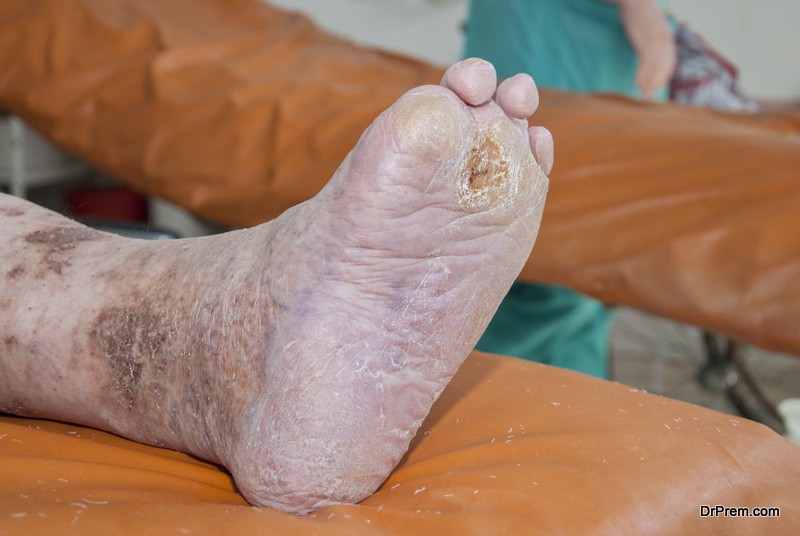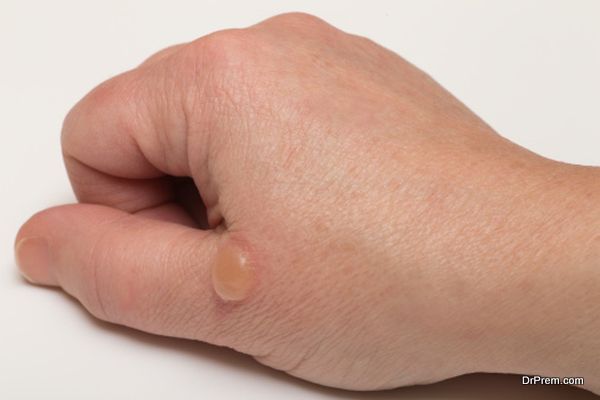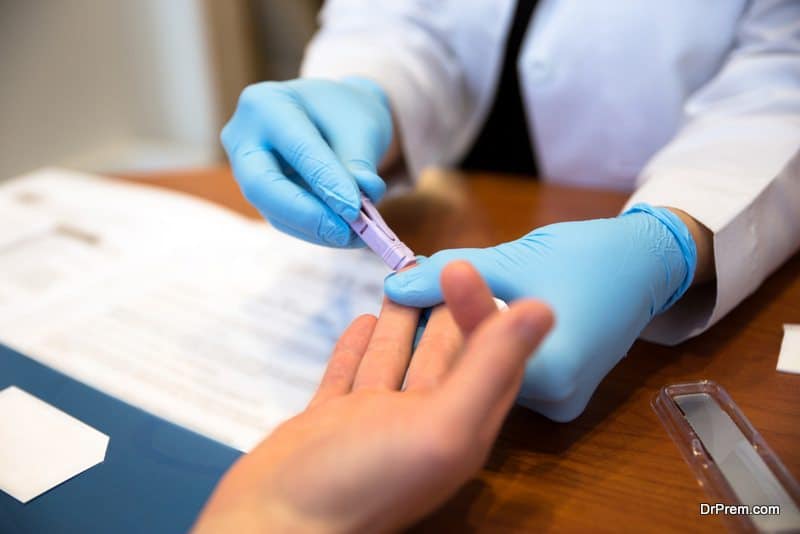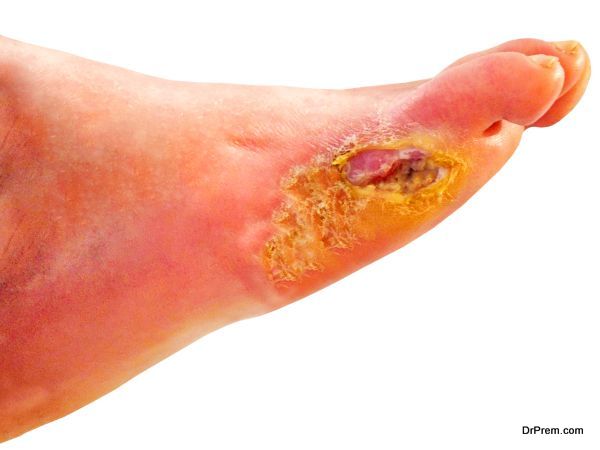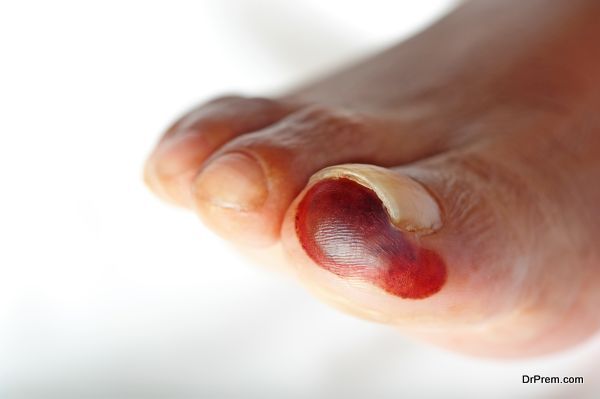We have been so far understood that chronic diabetes can at times be dangerous for all the vital organs of the body, such as kidneys, eyes, etc. Interestingly, a team of researchers from the California State University, conducted a study, wherein more than 1,00,000 patients were analyzed for the detrimental effects of their chronic diabetes. The results obtained were quite surprising, further suggesting that people with diabetes are more prone to infections. Let’s further see how?
Why diabetics are prone to infections and need special foot care
-
Overview
-
Infections associated with diabetes
-
Ear, Nose and Throat Infections
-
Urinary tract infections
-
Infections of skin and soft tissues
-
Osteomyelitis
-
Other infections
-
Why these infections are riskier in people with diabetes?
-
What can be done to avoid infections?
-
How proper feminine health can be maintained?
-
Diagnosing and treating infections
-
Important Foot Care Tips You Need To Know If You Are A Diabetic
-
What is foot care for diabetes?
-
How it is different from normal foot care?
-
Caring your toenails
-
Shoe and socks hygiene
-
For enhancing blood circulation in your feet
Overview
Diabetes is identified to be one of the most prevalent diseases in every nook and corner of the world. It is characterized by the increase in blood glucose level and a decrease in the cellular metabolism; either due to the absence of insulting or degeneration of insulin-producing beta cells. Investigations done so far, have proven that although diabetes seems to be a silent disease, it is quite prone to infections. Chronic exposure to the blood glucose level can lead to malfunctioning of various organs.
And hence, people with diabetes are being identified to increase the susceptibility of various infectious diseases, the details of which are mentioned further.
Infections associated with diabetes
As mentioned earlier, poorly controlled diabetes and continuous consumption of steroidal medications are responsible for a number of infections, mentioned herewith:
Ear, Nose and Throat Infections
Almost 70% of patients with diabetes have reported malignant infections, such as otitis externa as well as rhinocerebral mucormycosis. These infections are associated with bacterial growth in the external auditory canal that may progressively spread to other softer tissues, such as cartilages, bones, etc. Experts have suggested that these infections may result due to poor hygiene and lack of maintenance of proper blood sugar diabetic patients. Studies have evaluated that these organisms can grow in multiple colonies and pass through other softer tissues through different blood vessels.
Urinary tract infections
Diabetic patients are also prone to infections, such as urinary tract infections; possibly due to the increased risk of bacterial multiplications such as pyuria, cystitis etc. Diabetic patients, who are also suffering from pyelonephritis lose control over their diabetes, especially due to increased insulin resistance. People with diabetes may have a nauseatic feeling and hence may face difficulty in maintaining proper hydration. Although, it should be noted that many of these ailments if sugar is being considerably controlled through proper nutrition.
Infections of skin and soft tissues
People with diabetes are also prone to infections of the skin, sensory neuropathy, and atherosclerotic vascular diseases. In fact, several studies have indicated that skin and soft tissue infections are more common in chronic diabetics, of age more than 35 years. More commonly reported manifestations are a diabetic foot and other infections of feet.
Bullosis diabeticorum is commonly reported infection of acral skin in many chronic diabetics. However, blisters that are prevalent in this type of skin diseases may generally heal within less period of time.
Osteomyelitis
Skin ulcers, particularly poly microbial infections associated with chronic ulcers can spread to surrounding bones underneath. The disorder is known as osteomyelitis. Multiple studies have been carried out in this regard. One such study indicated that around 68% of people with diabetes reported diabetic foot ulcers due to chronic diabetes.
Unfortunately, when cultures from superficial skin infections tested for causative organisms; Staphylococcus was found to be quite prevalent.
Other infections
Many chronic patients with diabetes have commonly reported skin ulcer due to the contagious spread of bacteria and poor hygiene. The indication if left untreated for a longer period of time may affect adjacent bone of the skin underneath. Other infections, that have been reported are staphylococcal infections, Klebsiella infections, pneumococcal infections, etc.
Why these infections are riskier in people with diabetes?
People with diabetes are generally suffering from compromised immunity and hence are more prone to infections than other people. Studies have indicated that diabetics suffer from altered pH level due to elevated blood sugar levels, which is the leading cause of facilitating bacterial growth. It is also very interesting to note that patients, who have been hospitalized due to necessarily have higher mortality rates, but they do suffer from fatal infections that need urgent medical attention.
What can be done to avoid infections?
Careful inspection of feet and hands is critical to avoid issues related to the infections. Minor bumps and scratches should be avoided especially by people who are more prone to infections. The examination of feet should be carried out daily for any blisters, cuts, sores and other skin problems. Other infections like urinary tract infections, infections of ear, throat etc. can be avoided by maintaining proper hygiene, practicing proper toilet mannerisms etc.
Bacterial vaginal infections are common in women due to excessive bacterial growth in the vagina, which can further increase the chances of sexually transmitted diseases.
How proper feminine health can be maintained?
Women, who are more prone to infections can keep their diabetes maintained to avoid multiple attacks of infections. Accordingly, women can further reduce the complications by implementing certain precautionary measures, such as:
- Intake of Lactobacillus acidophilus through curd and over the counter supplements can be helpful for people with diabetes to ward off other bacterial infections. In the case of women, this can also facilitate the promotion of vaginal acidity to reduce the risk of infections.
- It should be noted that people who are more prone to infections should always maintain good hygiene by keeping their genitals clean and dry.
- Women should always avoid douching to prevent the growth of bacteria along the vaginal lining and further protect against infections.
- People with diabetes should keep themselves hydrated by drinking more water. This will help them to prevent drying of their genitals and skin.
Diagnosing and treating infections
One or more tests can be performed to diagnose infections associated with chronic diabetes, which may include blood tests, body secretions as well as urinary analysis. Many expert health care providers may prescribe oral as well as topical antibiotics, which can treat many fatal infections. Proper weight management, maintenance of hygiene and the implementation of proper safety procedures can help prevent infections and promote faster healing.
This may further prevent complications of people with diabetes and help maintain their high blood sugar at a prescribed level.
Important Foot Care Tips You Need To Know If You Are A Diabetic
Of all the diseases that can infect you, diabetes is perhaps the worst of them all. It is not an instantly fatal illness but can kill you slowly making your healing process delayed and difficult. More often than not diabetics do not pay attention to foot care which can be disastrous. In fact, a diabetic patient needs to be extra cautious about foot care than a normal person.
What is foot care for diabetes?
Diabetes often causes nerve damage impairing the normal blood circulation in the lower limbs. A simple cut or wound may give rise to chronic infection issues causing serious problems with your foot. Uncontrolled infection may lead to life threatening diabetic foot gangrene. You need to adopt extra safeguard to ensure your feet is healthy and free from infections. If you can control your diabetes, automatically you lower the chances of foot infection by several degrees.
How it is different from normal foot care?
You need to be more alert with your foot care. In general, foot care involves all aspects of preventive and corrective care about your feet, toes and ankles in consultation with specialists called Podiatrists.
For non-diabetics, foot care does not call for any serious attention. But the extra level of sugar in your blood is a big hindrance to the healing process if your feet and toenails get injured and infected.
Apart from regular blood sugar monitoring, additional foot care tips listed below would keep you in the safe side.
- Regular inspection of feet and toes is strongly advised. If you are unable to do it yourself due to some physical inability, you can use a mirror. You can ask someone to help you with your purpose.
- Make it a regular habit to wash your feet with warm water and mild soap. Too hot water may harm your feet. Check the water temperature with your fingers prior to dipping your feet in it. But do not test the temperature with your feet. They may not give you the correct picture as a diabetic foot turns insensitive to heat.
- Infections start in moist areas and so try to keep your feet dry always.
- You may apply moisturizer on your feet using lotion or oil. But a word of caution! Do not apply lotion in between your toes.
- Never apply undiluted antiseptic lotions to your feet. They can burn your skin around the area.
- Avoid application of heating pads, hot water bottles and electric blankets on your feet. They cause irreparable damage.
- Avoid walking barefoot. The habit may cause sores and injuries to your feet.
- Always guard your feet from coming in contact with the extremities of temperature.
- Use of razors, corn plasters, corn removers, calluses, chemical wart removers and other foot lotions are extremely harmful to your foot. You must see a good podiatrist to get a solution for issues concerning your foot.
- Never attempt to sit with your legs crossed or stand in one position for long. This hampers your normal blood circulation.
Caring your toenails:
An effective toenail care is an integral part of your diabetic foot care too. Here you should ensure the following:
– After washing your feet make sure you trim your toenail well.
– Cut your toenail straight and avoid cutting it along a rounded curve. It can cause in-growing toenail which is very painful.
– Don’t trim tour toenails too short.
Shoe and socks hygiene:
-Select the right fitting pair of shoes and socks. Your shoes must fit around well and should never be too tight
– Always wear a clean pair of socks. Try to wear cotton socks instead of wearing synthetic nylon ones. They trap sweat and make your foot moist encouraging bacterial infection.
– Select shoes having more depth in toe box and a good coverage of both top and bottom. The pair should not have inside seam that will constantly rub against your tender skin.
-Prefer wearing shoes made of canvas or suede instead of leather ones. This will prevent unnecessary sweating of your feet.
For enhancing blood circulation in your feet:
Try to keep the blood circulation in your feet going. This will reach oxygen and nourishment to every corner of your feet and toes reducing the chances of infection.
-You can do this by wriggling your toes and gently twisting your feet back and forth.
-Pick up the habit of regular walking. Foot muscles need exercise to remain healthy and active.
– Take vitamin B complex in consultation with your doctor. It improves the immune and nervous system. It can reduce your diabetes mellitus related issues.
Last but not the least carry on regular physical workouts along with maintaining a healthy diet to keep your blood sugar level and other vital parameters within a permissible range.


